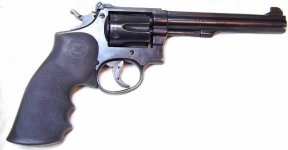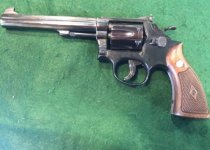I have an old "5-screw" K38 that I use as a backup for my "newer" k38 (4-screw, three in the side plate, one in front of the trigger guard) falling plate gun. I have the original wood grips for it, but prefer using the Hogue monogrips as per in the photos. Note that along with the 4-screws in the side plate, there is that fifth screw that enters in front of the trigger guard.



It is old enough that it does not have a "K" prefix to the serial number nor a "Mod-14" under the serial number.
Just a nice interesting old S&W target revolver.
I looked up the date of manufacture via the serial number at one time, but I don't remember the year anymore...don't really care.



It is old enough that it does not have a "K" prefix to the serial number nor a "Mod-14" under the serial number.
Just a nice interesting old S&W target revolver.
I looked up the date of manufacture via the serial number at one time, but I don't remember the year anymore...don't really care.
Last edited:








